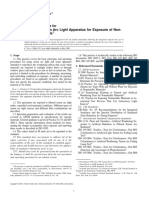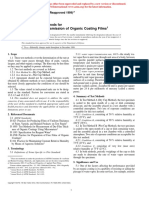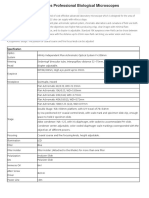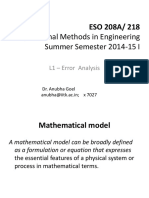At a glance
Powered by AI
This standard provides methods to calculate whiteness and yellowness indices from instrumentally measured color coordinates of near-white objects. It discusses derivations and uses of single-number scales for whiteness and yellowness as well as their limitations.
Designation: E 313 – 00
Standard Practice for
Calculating Yellowness and Whiteness Indices fromInstrumentally Measured Color Coordinates
1
This standard is issued under the fixed designation E 313; the number immediately following the designation indicates the year of original adoption or, in the case of revision, the year of last revision. A number in parentheses indicates the year of last reapproval. Asuperscript epsilon (
e
) indicates an editorial change since the last revision or reapproval.
This standard has been approved for use by agencies of the Department of Defense.
1. Scope
1.1 This practice provides numbers that correlate withvisual ratings of yellowness or whiteness of white and near-white or colorless object-color specimens, viewed in daylightby an observer with normal color vision. White textiles, paints,and plastics are a few of the materials that can be described bythe indices of yellowness or whiteness calculated by thispractice.1.2 For a complete analysis of object colors, by a specifiedobserver and under a specified illuminant, use of three param-eters is required. For near-white specimens, however, it is oftenuseful to calculate single-number scales of yellowness orwhiteness. This practice provides recommended equations forsuch scales and discusses their derivations and uses, and limitsto their applicability (see also Ref
(1)
2
).1.3
This standard does not purport to address all of thesafety concerns, if any, associated with its use. It is theresponsibility of the user of this standard to establish appro- priate safety and health practices and determine the applica-bility of regulatory limitations prior to use.
2. Referenced Documents
2.1
ASTM Standards:
D 1535 Practice for Specifying Color by the Munsell Sys-tem
3
D 1729 Practice for Visual Appraisal of Colors and ColorDifferences of Diffusely-Illuminated Opaque Materials
3
D 1925 Test Method for Yellowness Index of Plastics
4
E 284 Terminology of Appearance
3
E 308 Practice for Computing the Colors of Objects byUsing the CIE System
3
E 805 Practice for Identification of Instrumental Methods of Color or Color-Difference Measurement of Materials
3
E 991 Practice for Color Measurement of FluorescentSpecimens
3
E 1164 Practice for Obtaining Spectrophotometric Data forObject-Color Evaluation
3
E 1247 Test Method for Identifying Fluorescence in Object-Color Specimens by Spectrophotometry
3
E 1331 Test Method for Reflectance Factor and Color bySpectrophotometry Using Hemispherical Geometry
3
E 1345 Practice for Reducing the Effect of Variability of Color Measurement by Use of Multiple Measurements
3
E 1347 Test Method for Color and Color-Difference Mea-surement by Tristimulus (Filter) Colorimetry
3
E 1348 Test Method for Transmittance and Color by Spec-trophotometry Using Hemispherical Geometry
3
E 1349 Test Method for Reflectance Factor and Color bySpectrophotometry Using Bidirectional Geometry
3
E 1360 Practice for Specifying Color by Using the OpticalSociety of America Uniform Color Scales System
3
E 1499 Guide to the Selection, Evaluation, and Training of Observers
3
E 1541 Practice for Specifying and Matching Color Usingthe Colorcurve System
3
3. Terminology
3.1 Terms and definitions in Terminology E 284 are appli-cable to this practice.3.2
Definitions:
3.2.1
perfect reflecting diffuser
,
n
—ideal reflecting surfacethat neither absorbs nor transmits light, but reflects diffusely,with the radiance of the reflecting surface being the same for allreflecting angles, regardless of the angular distribution of theincident light.3.2.2
whiteness
,
n
—the attribute of color perception bywhich an object color is judged to approach the preferredwhite.3.2.3
whiteness index, WI
,
n
—a number, computed by agiven procedure from colorimetric data, that indicates thedegree of departure of an object color from that of a preferredwhite.3.2.4
yellowness
,
n
—the attribute of color perception bywhich an object color is judged to depart from colorless or apreferred white toward yellow.
1
This practice is under the jurisdiction of ASTM Committee E12 on Color andAppearance and is the direct responsibility of Subcommittee E12.04 on Color andAppearance Analysis.Current edition approved Dec. 10, 2000. Published February 2001. Originallypublished as E 313 – 67. Last previous edition E 313 – 98.
2
The boldface numbers in parentheses refer to the list of references at the end of this practice.
3
Annual Book of ASTM Standards
, Vol 06.01.
4
Discontinued; see
1994 Annual Book of ASTM Standards
, Vol 08.01.
1
Copyright © ASTM, 100 Barr Harbor Drive, West Conshohocken, PA 19428-2959, United States.
3.2.5
yellowness index, YI
,
n
—a number, computed by agiven procedure from colorimetric or spectrophotometric data,that indicates the degree of departure of an object color fromcolorless or from a preferred white, toward yellow.3.2.5.1
Discussion
—Negative values of
YI
denote departuretoward blue.3.3
Definitions of Terms Specific to This Practice
:3.3.1
near white
,
n
—a color having a Munsell value greaterthan 8.3 (luminous reflectance factor
Y
= 63) and Munsellchroma no greater than 0.5 for
B
hues, 0.8 for
Y
hues, and 0.3for all other hues.3.3.2
preferred white
,
n
—color of a white standard used asthe basis for calculating indices of whiteness or yellowness asthe departure of the color of the specimen from that of thepreferred white;
in this practice
, the perfect reflecting diffuser.
4. Summary of Practice
4.1 The calculations described in this practice assume thatspecimens have been measured according to Practices E 1164and E 308 and one of the Test Methods E 1331, E 1347,E 1348, or E 1349, depending on the type of specimen andmeasuring instrument used (see also Practice E 805).4.2 This practice takes as a starting point for the calculationsCIE tristimulus values
X, Y
, and
Z
for one of the CIE standardobservers and one of the CIE standard or recommendedilluminants of daylight quality. Such tristimulus values areavailable by use of modern color measuring instruments.4.3 Equations for the preferred methods of calculating
YI
and
WI
are described in Sections 6 and 7, respectively.Equations for calculating other quantities used as indices of yellowness or whiteness are given in Appendix X1 andAppendix X2, respectively.
5. Significance and Use
5.1 This practice should be used only to compare specimensof the same material and same general appearance. Forexample, a series of specimens to be compared should havegenerally similar gloss, texture, and (if not opaque) thickness,and translucency.5.2 For yellowness measurement, this practice is limited tospecimens having dominant wavelength in the range 570 to580 nm, or Munsell hue approximately 2.5
GY
to 2.5
Y
. Forwhiteness measurement, this practice is limited to specimenshaving Munsell value greater than 8.3 (CIE
Y
greater than 65)and Munsell chroma no greater than 0.5 for
B
hues, 0.8 for
Y
hues, and 0.3 for all other hues (see 3.3.1).5.3 The combination of measurement and calculation lead-ing to indices of yellowness or whiteness is a psychophysicalprocess, that is, the procedures specified are designed toprovide numbers correlating with visual estimates made underspecified typical observing conditions. Because visual observ-ing conditions can vary widely, users should compare calcu-lated indices with visual estimates to ensure applicability.Some standards addressing the visual estimation of color andcolor difference are Practices D 1535, D 1729, E 1360, andE 1541, and Guide E 1499.5.4 This practice does not cover the preparation of speci-mens, a procedure that may affect significantly the quantitiesmeasured. In general, specimens should be prepared andpresented for measurement in the manner that is standard forthe test being performed. Select enough specimens or specimenareas to provide an average result that is representative of eachsample to be tested. See Practice E 1345.
6. Yellowness Index
6.1
Background
—The currently recommended equation forthe calculation of yellowness index is derived from an equationdue to Hunter
(2)
in 1942:
YI
= (
A − B
)/
G
, where
A, B
, and
G
are, respectively, amber or red, blue, and green colorimeterreadings. Another version, used in the 1940s to 1960s fortransparent plastics
(3, 4)
, was based on transmittances near theends of the visible wavelength region:
YI
= 100(
T
680
−
T
420
)/
T
560
(with a factor of 100 introduced to give values of
YI
near unity). This equation failed to account correctly fordifferences in the spectral transmittance curves of such plastics,especially after the adoption of ultraviolet light absorbers toimprove weathering, and was soon abandoned. When, in 1957,ASTM solicited new equations for calculating yellownessindices, Hunter’s equation was converted
(5)
into CIE tristimu-lus value form by using Hunter’s approximate relations be-tween colorimeter readings and those tristimulus values; theresulting equation,
YI
= 100(1.28
X
− 1.06
Z
)/
Y
, was adoptedfor use in Test Method D 1925 in 1962.6.1.1 In the original form of Test Method E 313, an alter-native equation was recommended for a yellowness index. Interms of colorimeter readings, it was
YI
= 100(1 −
B/G
). Itsderivation assumed that, because of the limitation of theconcept to yellow (or blue) colors, it was not necessary to takeaccount of variations in the amber or red colorimeter reading
A
.This equation is no longer recommended.6.2
Significant Digits and Precision
— The coefficients of Test Method D 1925 equation were rounded to the number of digits shown, commensurate with the precision of then-existingcolor measurement instrumentation. It was not intended thatmore significance should be attributed to values of
YI
than thatimplicit in this number of digits. As instrumentation wasimproved, however, it was found that some instruments unex-pectedly gave nonzero values of
YI
for clear air or the perfectreflecting diffuser. One suggested (
(1)
, p. 205) remedy for thispresumed failure of the equation was to increase the number of digits in the numerical coefficients from two to ten after thedecimal point, despite the obvious lack of significance of mostof these digits. With modern instrumentation, it is believed thattwo digits added to the coefficients in the original Test MethodD 1925 equation suffice to bring the nonzero value of
YI
below0.0005 on average. The new coefficients are given to thisprecision in 6.3.6.3
Derivation of Equations
—Several sets of coefficientsare involved in the derivation of the final equations recom-mended for calculating yellowness indices. With them evalu-ated, it is possible to derive highly precise equations for boththe CIE 1931 standard observer and the 1964 supplementarystandard observer, in combination with either CIE standardilluminant
C
or
D
65
. The results are given in Table 1.6.3.1 The first set of coefficients required, consists of thetristimulus values
X
n
,
Y
n
, and
Z
n
of the perfect reflectingdiffuser (or clear air) for the above observer-illuminant com-binations. These are established by the CIE, and for the present
E 313
2
derivation were taken from the tables of tristimulus weightingfactors in Practice E 308.6.3.2 From these “white point” values, it is possible tocalculate the coefficients in Hunter’s equation relating tristimu-lus value
X
and colorimeter readings
A
and
B
:
X = X
n
(
F
A
A
+
F
B
B
), thus improving on the approximation
F
A
= 0.8 and
F
B
= 0.2 originally used.6.3.3 Finally, the coefficients in revised Test Method D 1925equations for
YI
can be calculated, rounded, and adjusted in thelast retained significant digit to minimize the residual error inthe white point values. These coefficients are given in Table 1as
C
X
and
C
Z
in the recommended equation for yellownessindex:
YI
5
100
~
C
X
X
2
C
Z
Z
!
/
Y
(1)
The tabulation of the residual white point error completes thetable.
7. Whiteness Index
7.1
Background
—The earliest equation for whiteness index
WI
appears to be due to MacAdam
(6)
and related
WI
toexcitation purity. This and other equations utilizing the purityhave largely been abandoned. Judd
(7)
appears to have been thefirst to recognize that a whiteness index should incorporate twoterms, one based on the lightness of the specimen relative tothat of a preferred white, and the other describing the differ-ence in chromaticity between the specimen and that preferredwhite. Much debate has arisen over the years as to the natureof the preferred white, but at the present time the perfectreflecting diffuser is almost always adopted as that reference.7.1.1 In the original form of Test Method E 313, theequation for
WI
was based on the above premise and the use of colorimeter readings
G
and
B
only. It was found that thechromaticity factor
G − B
required three to four times theweighting of the lightness factor
G
. Hence the equation waswritten
WI = G
− 4(
G − B
) = 4
B
− 3
G
. This equation is nolonger recommended.7.2
CIE Equations
—The equations for whiteness recom-mended in this practice were derived and published
(8)
by theCIE. Two equations are given, one for the whiteness index
WI
and another for a tint index
T
. Their coefficients are given inTable 2. The CIE gave coefficients for both standard observersand Ill.
D
65
; those for the 1931 observer and Ill.
C
were takenfrom the American Association of Textile Chemists and Col-orists (AATCC) method for
WI
(9)
; and those for the 1964observer and Ill.
C
and Ill.
D
50
were estimated by Subcommit-tee E12.04. Those for Ill.
C
and Ill.
D
50
and both observers areunofficial and should be used for in-house comparisons only.7.2.1
Equation for Whiteness Index WI
:
WI
5
Y
1
~
WI
,
x
! ~
x
n
2
x
!
1
~
WI
,
y
! ~
y
n
2
y
!
(2)
where:
Y, x, y
= the luminance factor and the chroma-ticity coordinates of the specimen,
x
n
and
y
n
= the chromaticity coordinates for theCIE standard illuminant and sourceused, and
WI, x
and
WI, y
= numerical coefficients.Values for all these except those measured for the specimenare given in Table 2.7.2.2
Equation for Tint Index T
:
T
5
T
,
x
~
x
n
2
x
!
2
T
,
y
~
y
n
2
y
!
(3)
where the symbols have meanings analogous to those in7.2.1.7.3
Notes and Restrictions to the CIE Equations
—The CIEnotes the following regarding the use of equations for
WI
and
T
:7.3.1 The application of the equations is restricted to speci-mens that are called “white” commercially, that are similar incolor and fluorescence, and that are measured on the sameinstrument at about the same time. Under these conditions theiruse should give relative, but not absolute, evaluations of whiteness that are adequate for commercial use.7.3.2 The higher the value of
WI
, the greater is the indicatedwhiteness. The more positive the value of
T
, the greater is theindicated greenish tint of the specimen; the more negative thevalue of
T
, the greater is its reddish tint. Lines of equal
T
areapproximately parallel to the line of dominant wavelength 466nm. For the perfect reflecting diffuser,
WI
= 100 and
T
= 0.7.3.3 Equal differences in
WI
or
T
do not always representequal perceptual differences in whiteness or tint, respectively.7.3.4 These equations should be used only for specimenswith 40 <
WI
< (5
Y
− 280) and −3 <
T
< +3.
8. Apparatus
8.1
Color Measuring Instrument
—Spectrophotometer ortristimulus (filter) colorimeter, capable of producing CIE tris-timulus values and chromaticity coordinates for either CIEstandard observer and the desired CIE standard illuminants of daylight quality, for a CIE recommended geometry. Theinstrument should meet the manufacturer’s requirements forcalibration.8.1.1 If the specimens are known or suspected to befluorescent (see Test Method E 1247), the choice of instrumentoptical geometry can affect the measurement results. When
TABLE 1 Coefficients of the Equations for Yellowness Index
QuantityCIE Standard Illuminant and Standard Observer
C
, 1931
D
65
, 1931
C
, 1964
D
65
, 1964
X
n
98.074 95.047 97.285 94.811
Y
n
100.000 100.000 100.000 100.000
Z
n
118.232 108.883 116.145 107.304
F
A
0.7987 0.8105 0.7987 0.8103
F
B
0.2013 0.1895 0.2013 0.1897
C
X
1.2769 1.2985 1.2871 1.3013
C
Z
1.0592 1.1335 1.0781 1.1498Residual error −0.0006 −0.0004 −0.0004 −0.0006
TABLE 2 Coefficients for the Equations for CIE Whiteness Indexand Tint
ValueCIE Standard Illuminant and Observer
C
, 31
D
50
, 31
D
65
, 31
C
, 64
D
50
, 64
D
65
, 64
x
n
0.3101 0.3457 0.3127 0.3104 0.3477 0.3138
y
n
0.3161 0.3585 0.3290 0.3191 0.3595 0.3310
WI, x
800 800 800 800 800 800
WI, y
1700 1700 1700 1700 1700 1700
T, x
1000 1000 1000 900 900 900
T, y
650 650 650 650 650 650
E 313
3
hemispherical (integrating sphere) geometry is used for mea-suring fluorescent specimens, the spectral power distribution of the illuminating system may be altered by the reflected andemitted power from the specimen. The use of bidirectionalgeometry is therefore preferable. In addition, follow therequirements of Practice E 991 with respect to the spectraloutput of the instrument illuminator.8.2
Standards
—The primary standard of reflectance shall bethe perfect reflecting diffuser. Instrument standards calibratedin terms of the perfect reflecting diffuser or the perfecttransmitting diffuser shall be used in standardizing the instru-ment.
9. Procedure
9.1 Operate the color measuring instrument according to themanufacturer’s instructions for standardization and measure-ment. Refer to Practices E 308 and E 1164 and, according tothe instrument type and geometry, Test Method E 1331,E 1347, E 1348, or E 1349.9.1.1 In addition to the standards required or furnished bythe manufacturer, it is desirable to measure periodically one ormore system verification standards with known values of yellowness or whiteness.9.2 If not carried out automatically by the instrument, print,display, or store values of
X, Y, Z, x, y
for the specimens for usein calculations.9.2.1 Make as many repeat measurements as required (referto Practice E 1345) and average the resulting values of
X, Y, Z, x, y
. Use the averaged values in calculations.
10. Calculations
10.1 As required, calculate for each specimen the value of
YI
by Eq 1, of
WI
by Eq 2, and of
T
by Eq 3.10.1.1 Refer to Appendix X1 and Appendix X2 for otherequations used in the past for calculating indices of yellownessand whiteness. Such equations may be used if desired, but theresulting values will in all probability differ from thoseobtained by use of the recommended equations of this practice.
11. Report
11.1 The report shall include the following information:11.1.1 Manufacturer, model, geometry, and any furtheridentification required for the instrument used,11.1.2 Illuminant(s) and observer(s) for which data arereported,11.1.3 Specimen identifications and measured values of
X,Y, Z, x, y
for each measurement,11.1.3.1 If multiple measurements were made of a singlespecimen and set of conditions, number of measurements andaverage values of
X, Y, Z, x, y
,11.1.4 Indices of yellowness, whiteness, and tint as re-quired, and11.1.5 Special considerations including the following:11.1.5.1 If the specimens were fluorescent, details of theinstrument light source as required in Practice E 991, and11.1.5.2 If the specimens were transparent or translucent,the thickness of each specimen.
12. Keywords
12.1 color; colorimetric analysis; instrumental measure-ment; color/light; reflectance; reflectivity; whiteness indexes;yellowness indexes
APPENDIXES
(Nonmandatory Information)X1. ALTERNATIVE MEASURES OF YELLOWNESS
X1.1
Positive Values of the Yellowness-Blueness Coordi-nate of Any Opponent-Color Space:
X1.1.1 Such coordinates include Hunter
b
Refs
(1, 5)
;CIELAB
b
*, (Refs
1, 8
, and Practice E 308); and CIELUV
v
*(Refs
1, 8
, and Practice E 308). The equations for thesecoordinates are given in the references cited.X1.2
Values of the Chroma Coordinate of Any Opponent-Color Space When Expressed in the Coordinates Hue, Light-ness, and Chroma:
X1.2.1 Such coordinates include chroma derived for theHunter system:
C
H
5
~
a
2
1
b
2
!
1/2
(X1.1)
and CIELAB and CIELUV chromas. The equations for thesequantities are given in the references cited in X1.1.1.X1.3 Hunter
b
8
, Ref
(2)
:
b
8
5
88.4
G
1/4
~
G
2
B
!
/
~
R
1
2
G
1
B
!
(X1.2)
X1.4 Scofield
b
Refs
(1, 10)
:
b
5
2
B G
1/2
~
G
2
B
!
/
~
R
1
2
G
1
B
!
(X1.3)
X1.5 Friele’s Yellowness Index Refs
(1, 11)
:
YI
5
1/2
~
R
1
G
!
/
B
(X1.4)
X1.6 Optical Society of America Uniform Color Scales
j
(Ref
12
, and Practice E 1360):
j
5
C
~
R
1/3
1
8
G
1/3
2
9.7
B
1/3
!
(X1.5)
where the quantities required for the calculation are definedin Eqs 3, Eqs 5, and Eqs 6 of Practice E 1360.X1.7 The equation
YI
= 100(1 −
B/G
) discussed in 6.1.1.
E 313
4































































































